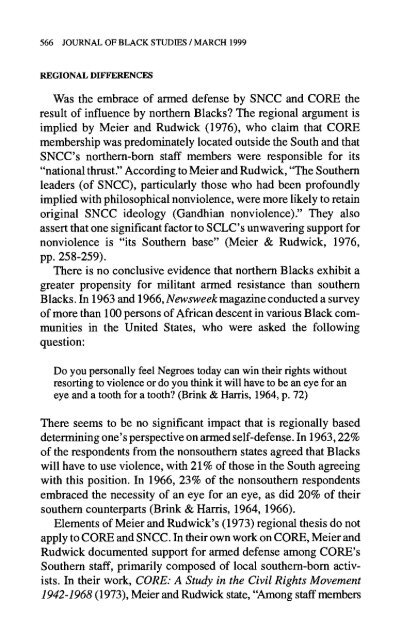MXGM Self-Defence Manual
MXGM Self-Defence Manual
MXGM Self-Defence Manual
Create successful ePaper yourself
Turn your PDF publications into a flip-book with our unique Google optimized e-Paper software.
566 JOURNAL OF BLACK STUDIES / MARCH 1999<br />
REGIONAL DIFFERENCES<br />
Was the embrace of armed defense by SNCC and CORE the<br />
result of influence by northern Blacks The regional argument is<br />
implied by Meier and Rudwick (1976), who claim that CORE<br />
membership was predominately located outside the South and that<br />
SNCC's northern-born staff members were responsible for its<br />
"national thrust." According to Meier and Rudwick, "The Southern<br />
leaders (of SNCC), particularly those who had been profoundly<br />
implied with philosophical nonviolence, were more likely to retain<br />
original SNCC ideology (Gandhian nonviolence)." They also<br />
assert that one significant factor to SCLC's unwavering support for<br />
nonviolence is "its Southern base" (Meier & Rudwick, 1976,<br />
pp. 258-259).<br />
There is no conclusive evidence that northern Blacks exhibit a<br />
greater propensity for militant armed resistance than southern<br />
Blacks. In 1963 and 1966, Newsweek magazine conducted a survey<br />
of more than 100 persons of African descent in various Black communities<br />
in the United States, who were asked the following<br />
question:<br />
Do you personally feel Negroes today can win their rights without<br />
resorting to violence or do you think it will have to be an eye for an<br />
eye and a tooth for a tooth (Brink & Harris, 1964, p. 72)<br />
There seems to be no significant impact that is regionally based<br />
determining one's perspective on armed self-defense. In 1963,22%<br />
of the respondents from the nonsouthern states agreed that Blacks<br />
will have to use violence, with 21 % of those in the South agreeing<br />
with this position. In 1966, 23% of the nonsouthern. respondents<br />
embraced the necessity of an eye for an eye, as did 20% of their<br />
southern counterparts (Brink & Harris, 1964, 1966).<br />
Elements of Meier and Rudwick's (1973) regional thesis do not<br />
apply to CORE and SNCC. In their own work on CORE, Meier and<br />
Rudwick documented support for armed defense among CORE's<br />
Southern staff, primarily composed of local southern-born activists.<br />
In their work, CORE: A Study in the Civil Rights Movement<br />
1942-1968 (1973), Meier and Rudwick state, "Among staff members


